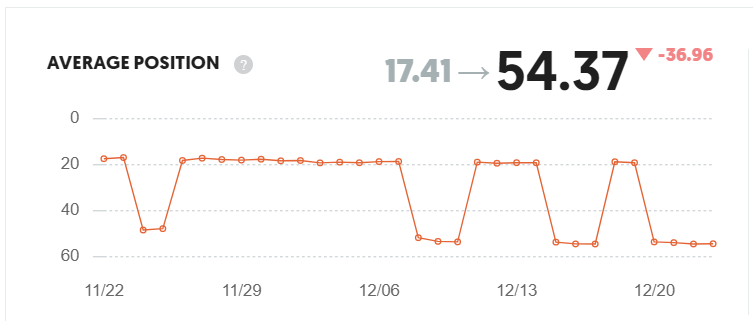OTHER
Google Ranking Teetering In & Out Over Weekends

Google Search seems to be ranking some websites just fine during the weekdays and then removing that ranking over the weekends. It seems to be focusing heavily on non-standard TLDs, you know, those new vanity TLDs that you can make up. I am just not sure if this is a Google Search issue or if the issue is with the quality of those websites.
The super interesting part is that most of the dates of these ranking drops coincide with the weekend Google search ranking updates that we covered here. Each of these drops for these sites happened with this unconfirmed Google search ranking updates. That is not to say that only these non-standard TLDs are having issues, I asked the folks on this site deep inside the comments several days ago if their sites that were impacted were non-standard TLDs, and the vast majority said no, they were on .com TLDs.
The first person I saw cover this was Tomasz Rudzki at ZipTie. In short, he wrote, “On weekends, something strange kept happening – the website would completely lose rankings and traffic. People couldn’t even find it when they searched for it by its name.”
The dates he shared coincided with the algorithm updates I reported on. He said these were the dates:
He said, “9 out of 9 examples were non-standard TLDs, such as, .consultancy (example.consultancy), .care (example.care), .club, .info, .energy. Again, in my research, many other sites on .com’s and other standard TLDs seemed to have been impacted.
Then the other day Olesia Korobka posted on X about a support thread with a similar issue. Olesia wrote, “The question is if all websites in .media, club, clinic etc experience the issue? Or could it be a mix of locality and tld or something else?”
The question is if all websites in .media, club, clinic etc experience the issue? Or could it be a mix of locality and tld or something else?https://t.co/kehMg3phLS
— 🐝 Olesia Korobka 💙💛🐝 (@Giridja) January 16, 2024
I digged into the thread and yes, these are all non-standard TLDs and the dates match with what Tomasz Rudzki covered. Last night, Roger Monti covered this thread as well, calling it a bug. Here are some examples from the thread in the Google Webmaster Help Forums:
The person wrote, “Since late November, my website has been periodically disappearing from Google’s search results, impacting its online presence and traffic significantly. This issue has occurred seven times since then, with my site returning to its previous positions six times but currently being absent again.” They shared this chart and links to similar complaints in the forums.
Here are more charts from the threads:
Now, is this some sort of bug with Google Search? Maybe.
Or maybe it has to do with some of these sites being on the edge of indexing with the edge of quality. We initially thought when we reported on those issues that it was a bug with Google indexing some sites but Google said no, it was an issue with these sites being on the edge of quality and Google doesn’t think it is worth indexing. Google has told us pages/sites can pop in and out of its index when they are on the edge of quality, that threshold of being quality enough or not enough to be in the Google index.
And I don’t think it is just limited to the non-standard TLDs based on what I have been tracking with these weekend updates.
I think Google’s quality line for indexing content has been super weird over the past few months and maybe, just maybe, that is what is going on.
Or maybe it is a bug? I am not sure.
What do you all think?
Forum discussion at Google Webmaster Help, X and X.





















